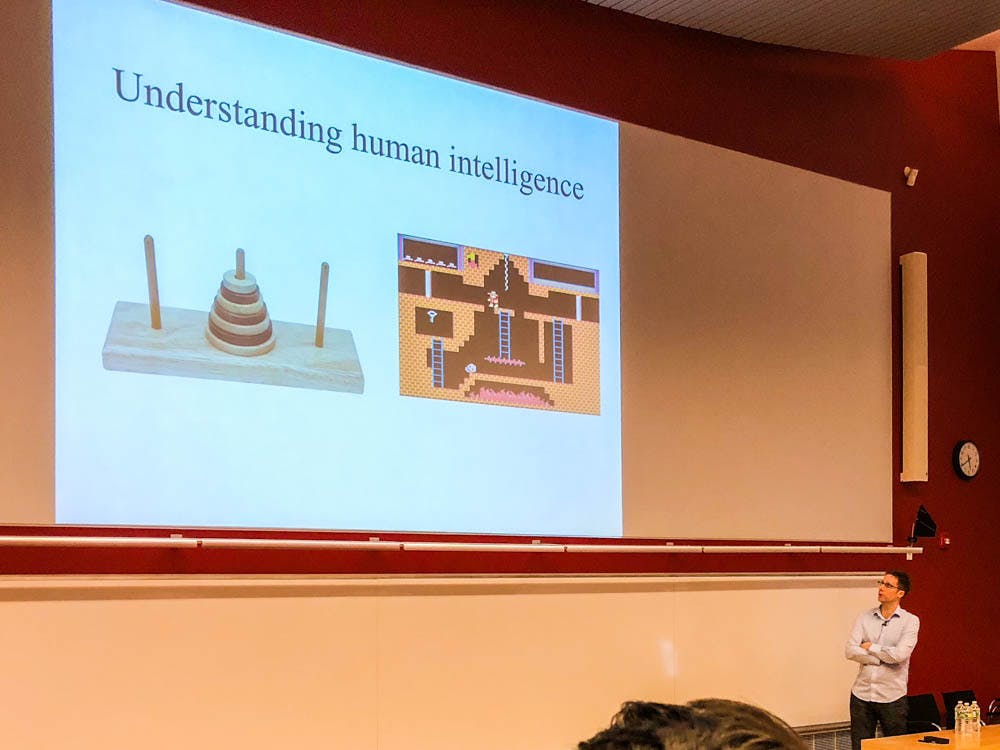With the buzzword “data-driven” gaining traction as a hot topic within many disciplines today, researchers and students flocked to the Serre Lab’s workshop on deep learning and the field’s myriad applications last Saturday.
Deep learning is a set of algorithms that analyzes a large amount of data to improve specific processes under study. The workshop, “Beyond Deep Learning,” is part of a lecture series that aims to bring together cognitive science and computer science to present new ways for approaching artificial intelligence and its plethora of applications.
Tom Griffiths, professor of psychology and cognitive science at Princeton, Dima Amso, associate professor of cognitive, linguistic and psychological sciences�� and David Heeger, professor of psychology and neural sciences at New York University, spoke Friday afternoon about recent advancements in mapping biological human intelligence to create computational models for artificial intelligence.
Heeger focuses on a few different fields: working memory from cognitive psychology, computer science algorithms and their�� overall connection to neurobiology.
“Working memory is a cognitive process that is responsible for both maintaining and manipulating information over time,” Heeger said. Working memory requires combining information encountered in the present with past memory and experiences, he added.
On the other hand, computers do not have an unlimited amount of memory to store information, Heeger said. “The concept is that you have a state that you update over time, and you carry forward some information and throw away some information and transform some information,” he added. This constraint makes it difficult for researchers to model working memory, since working memory necessitates access to past experiences that computers may have overwritten.
In contrast to working memory, “psychologists use the term ‘short-term’ memory just to refer to maintenance of information over time” but not the manipulation of such information, Heeger said.
In recent years, researchers have begun to use an algorithm called a Long-Short Term Memory network to manipulate information. Such manipulation more closely resembles the processes involved in working memory as opposed to short-term memory.
LSTMs are “simple algorithms that can solve seemingly complicated tasks,” Heeger said. Such tasks can include language modeling and eye movement tracking.
Essentially, eye movement requires that the brain manipulate information on a coordinate basis — a process that researchers now track with LSTM algorithms, Heeger said. “Working memory and other kinds of executive function such as attention may depend on the same computational engine as motor preparation, motor control and sensory processing,” he added.
Griffiths took the podium to discuss using computer science to create predictions about human behavior. Researchers hope to explain how we interpret information in the world from natural stimuli that are faced everyday and not just simplistic stimuli, he added.
Griffiths uses computer science to study an individual’s psychological visualization of an image rather than the activity of neurons.
The issue is that these representations “are not really things you can see or touch. We have to rely on behavior to tell us about what some of those underlying representations might be,” Griffiths said. While machine learning sheds light on behavior prediction, it raises the challenge of explaining that behavior, he added.
“In reality, there are a lot of complex stimuli that humans face, so it’s important for computers to be able to analyze this vast amount of information and model how humans classify their information in order to interpret it,”
Griffiths said. Researchers can then model the behavior and decisions that people make and “predict peoples’ classification behavior very well,” he added.
This empirical treatment of psychology is unusual because the subject is normally studied with theoretical models, Griffiths said. Now, researchers can look at inputs and data facilitated by computational methods in order to make predictions about behavior, he added.
“We sort of passed the threshold where hand-engineered models had more bias (than the deep learning models),” Griffiths said.
While Griffiths’ work uses computational methods to understand human behavior, Amso’s research is focused on how we can use human behavior, especially in the case of infants, to inform computer science.
There is a high amount of complexity in human-infant interactions, not only in the baby’s actions, but also in the data the baby is receiving, Amso said. Information enters the system through the senses first and then enters the brain, she added. “This gives me a framework (from which) to ask my questions so that I don’t ask my questions in a way that is inconsistent with the biology of the system,” she said.
Researchers must take into account how the visual system is developed. To address this, researchers use eye trackers to monitor where a baby is looking in order to see if the baby is observing the whole image and actually understanding what is happening, she said.
But “the data depend on the state of the visual system … and the full visual field is not sufficient” to determine what the baby is actually understanding and viewing in the world. Tactile information is necessary for babies to actually get an idea of the 3-D shape of objects and the world around them.
“I think (this series) does a good job bringing together the psychology department at Brown, which has a strong computational history, and the strong computer science department,” Harrison Ritz GS said.
“I always think it is pretty cool to see the intersection of neuroscience and computer science, as someone who works in machine learning,” Dan Shiebler ’15 said.




